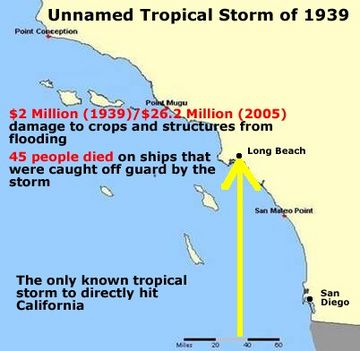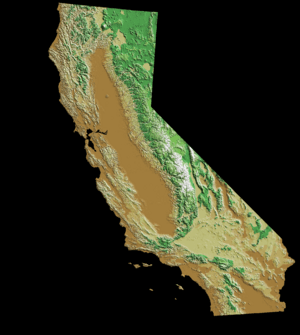1939 California tropical storm facts for kids
| Category 1 hurricane (SSHWS/NWS) | |

Storm path
|
|
| Formed | September 15, 1939 |
|---|---|
| Dissipated | September 25, 1939 |
| Highest winds | 1-minute sustained: 75 mph (120 km/h) |
| Lowest pressure | 971 mbar (hPa); 28.67 inHg |
| Fatalities | 45–93 direct |
| Damage | $2 million (1939 USD) |
| Areas affected | Southern California, northwestern Mexico |
| Part of the 1939 Pacific hurricane season | |
The 1939 California tropical storm was a very unusual weather event. It is also known as the 1939 Long Beach tropical storm or El Cordonazo. This storm was a tropical cyclone that hit Southern California in September 1939. It was the only tropical storm to make landfall in California during the entire twentieth century. Fishermen along the Mexican coast called these storms "The Lash of St. Francis". This storm caused a lot of flooding and sadly, many people died, especially at sea.
Contents
How the Storm Formed and Moved
On September 15, a tropical depression started forming near Central America. A tropical depression is like a baby hurricane, with winds starting to spin. It moved west and then turned north. For a while, it grew into a full hurricane, which is a very strong storm. But it lost some of its power and became a tropical storm again by September 25.
The storm then made landfall near San Pedro, California, early on September 25. It had strong winds, like a severe gale. The storm disappeared later that same day. One ship reported winds strong enough to be called a minimal hurricane. This ship also recorded the lowest pressure, which means the storm was very intense at that point.
Why Storms Rarely Hit California
Tropical cyclones in the Northern Hemisphere usually move from east to west because of how the Earth spins. This means they rarely come close to the West Coast of the United States.
Another reason storms don't often hit California is the ocean water temperature. The water off California's coast is usually too cold for hurricanes to stay strong. Hurricanes need warm water (above 70°F or 21°C) to keep their power.
This 1939 storm was very rare. Only three other storms from the eastern Pacific brought strong winds to the United States during the 1900s. The Long Beach Tropical Storm was the only one that actually made landfall in California. The other three hit Mexico first and then moved north, but they didn't cross into California.
Storm's Impact and Damage
The storm brought a huge amount of rain to California. For example, Los Angeles received 5.66 inches (144 mm) of rain, which was a September record. Mount Wilson got an amazing 11.60 inches (295 mm) of rain. In just three hours, one thunderstorm dropped almost 7 inches (178 mm) of rain in Indio. This heavy rain caused a lot of flooding. The Coachella Valley saw floods 2 to 4 feet (0.6 to 1.2 meters) deep. The Los Angeles River, which is usually low in September, turned into a fast-moving river.
Deaths and Dangers at Sea
The heavy rain and flooding caused many deaths in Southern California. At least 45 people died on land, and 48 people died at sea. Six people drowned on beaches during the storm. Most of the other deaths happened to people on boats.
- Twenty-four people died on a boat called the Spray near Point Mugu. Only two people survived by swimming to shore.
- Fifteen people from Ventura drowned on a fishing boat named Lur.
- Many other boats sank, flipped over, or were pushed onto the shore by the strong winds and waves.
Flooding and Property Damage
Many low-lying areas were completely flooded. The Hamilton Bowl overflowed, flooding the Signal Hill area. Houses along the coast from Malibu to Huntington Beach were filled with water. Thousands of people were stuck in their homes.
Streets in Los Angeles were covered with water, flooding buildings and stopping cars. In Inglewood and Los Angeles, the water was 2 to 3 feet (0.6 to 0.9 meters) deep. Construction on a flood control project for the Los Angeles River had to stop because of the floods.
In Long Beach, the wind was so strong that it broke many windows. At Belmont Shore, strong waves washed away ten homes. Debris was scattered all along the coast.
Damage to Infrastructure and Agriculture
The storm also damaged important infrastructure:
- A 150-foot (46 m) section of the Southern Pacific Railroad near Indio was washed away.
- A part of the Santa Fe main railway line near Needles was also damaged.
- A storm drain under construction in the Santa Monica Valley caused U.S. Route 60 to be blocked by water.
- The pier at Point Mugu was completely destroyed.
In Pasadena, 5,000 people lost electricity, and 2,000 telephones stopped working. Communication across the affected areas was very difficult or impossible. The total damage from the storm was about $2 million in 1939 money. This would be much more today, about $42 million in 2022 money.
One Good Thing and Future Changes
Even with all the damage, the storm did have one positive effect: it ended a very bad heat wave that had lasted for over a week and had killed at least 90 people.
People were not ready for this storm, and it was described as "sudden." Some people were still on the beach at Long Beach when the winds reached 40 mph (64 km/h). Lifeguards quickly closed the beach, and schools were shut down.
At sea, the Coast Guard and Navy worked hard to rescue dozens of people. Because Californians were so unprepared, the Weather Bureau decided to open a special forecast office for Southern California. This office started working in February 1940 to help people be more ready for future storms.
Images for kids
See also
 In Spanish: Tormenta tropical de Long Beach de 1939 para niños
In Spanish: Tormenta tropical de Long Beach de 1939 para niños



